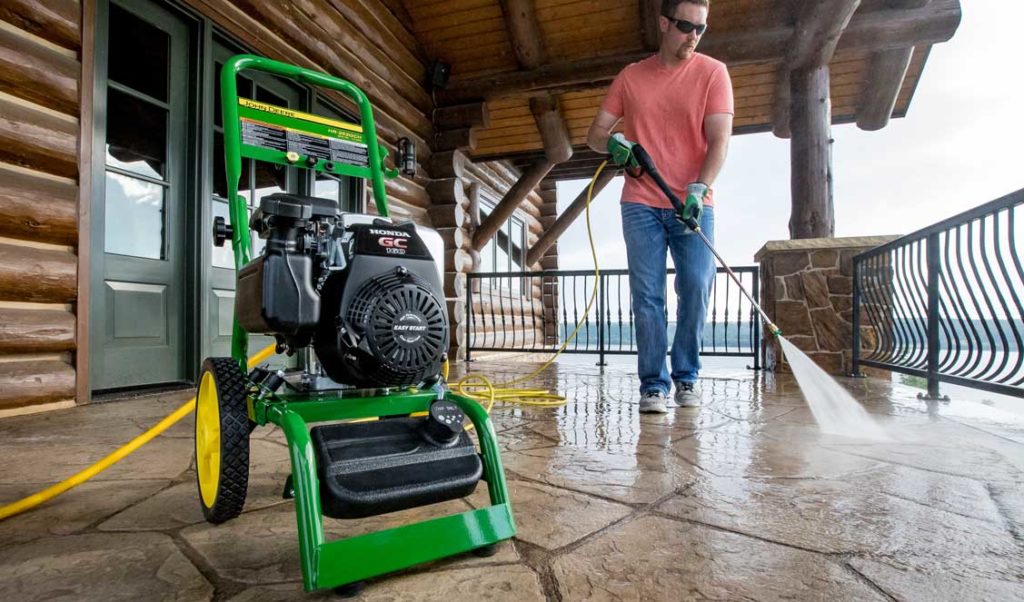
Surf Google or YouTube for the trendy videos, and you will see one common outcome, “Pressure Washer Cleaning.” In all those exciting videos, YouTubers showcase the power of water pressure creatively while comparing the cleaned area before and after.
These videos are alluring, but have you ever indeed deeply thought about how does a pressure washer work?
Not really, right?
Then, you need to think again. Once you learn how a pressure washer work, you will be able to fix the minor issues along with the efficient cleaning sessions.
So, are you up for it?
How Does A Pressure Washer Work?
When it comes to the working process of a pressure washer, there are two ways to explain the scenario.
First off, we can choose the regular way- staffing our article with scientific terms and swindle you.
Secondly, we can elaborate on the pressure washer working process in easy and understandable language.
For your convenience, we opted the 2nd way. But even after that, we wanted to break down the working from one technical and scientific viewpoint. As we know, water is a polar chemical, so when it gets attached to any chemical component of the grime and debris, it doesn’t damage the bonding much.
But due to the high-pressure, the water comes out from the washer mixed with soap or detergent, which does the cleaning job done. The pressure washer with around 1000-3000 PSI successfully breaks down the chemical bonding for a crisp cleaning in a snap.
A quick summary of the pressure washer working process
- The first water hose connects with the pressure washer detergent soap water container. It then lets the detergent flow into the leading pressure washer and gets mixed with the cold water.
- The 2nd hose connects with the water supply source and comes into the pressure washer. On the way, the water from the faucet gets filtered for a cleaning job.
- The pressure washer runs on either electricity or gas or sometimes diesel. It depends on the fuel type the appliance is made for, and once you turn on the device, the motor will kick-off the washer.
- Once you trigger the power button, the pressure washer starts working. At first, the impeller, aka, water pump, draws both the cold water and detergent in the main container.
- Then the water pump mixes both ingredients properly through pressure stirring.
- The most pressure washer will also heat the cold water to an optimal temperature of around 50°C to 70°C. The warm water works exceedingly with the detergent for an efficient cleaning session.
- The water pump then will squirt out the warm water and detergent mixture as soapy water through the attached pressure hose. There’s a narrow nozzle that you will find connected with the high-pressure washer hose. It enables the soapy water to come out from the pump with jet speed. Sometimes, the water speed is even more.
- With such high-pressure and speed, the pressure washer successfully cleans all dirt and grime to present you with a neat and clean surface. Also, a pressure washer will use at least 75%-80% less water compared to the regular garden hose used for cleaning.
That’s how an efficient pressure washer works to keep your lawns, gardens, patios, and driveways clean as a whistle.
Pressure Washer Parts
Now we know how a pressure washer effectively cleans every dirt and grime, you may be interested to know the parts of the device that performs so brilliantly.
- Electric or gas engine: A pressure washer works either with an electric motor or a gas engine. Electric models are most suitable for working home interior while the gas engine is for exterior use where getting a power source may not be secure.
- Water pump: If the motor is the heart of a pressure washer, the pressure washer pump is its muscles. The engine delivers the right power to the pump, and it then sucks water from the water faucet. It also mixes the water with the detergent and sprays it out with another exterior hoe outlet.
- Water inlet: The water inlet connects the main water supply with the pressure washer. You will find an inlet washer inside the device. It protects the debris or other unexpected materials from getting into the inlet.
- High-pressure hose: It connects the water inlet with the exterior water attachment, often a nozzle to start the cleaning jobs. A high-pressure washer is made of reinforced mesh wire and two to three layers of interior plastic or rubberized tubing. The brilliant engineering permits you to work with the extreme water pressure.
- Cleaning attachments: You may attach a trigger gun or a wand spray to perform different cleaning jobs with the pressure washer.
These five parts incorporate each other to make your every washing job a breeze. All these parts are made of high-quality materials that will withstand years of wear and tear. So, you get almost a lifetime guarantee for the pressure washer.
Conclusion
A pressure washer is a brilliant cleaning tool. Once you get the right attachment with the appliance, your cleaning job will never be the same.
That’s the reason we have described the pressure washer working process elaborately so that you know how it works. Also, it will help you come with better output and fix the minor issues efficiently. So, it’s a real money-saver deal.





